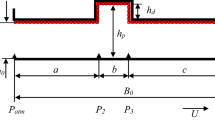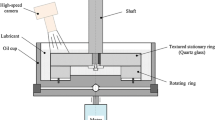Abstract
The value of cavitation pressure plays an important role in the implementation of the mass-conservative algorithm. This is particularly crucial in applications that deal with analysis of surface textures. In this paper, published research on cavitation of journal bearing and surface textures are reviewed, and experiments and simulations of textured surface are conducted in order to gain insight into the choice of cavitation pressure for steady-state lubrication. Contrary to the common assertion that cavitation pressure is close to the ambient pressure, both experiments with journal bearings and simulations of surface textures indicate that low cavitation pressure around 30 kPa is possible. Research reveals that the cavitation pressure in steady-state lubrication is affected by the supply of gas dissolved in the oil film. The results of a series of experiments involving the load-carrying capacity of a textured parallel thrust bearing are presented. The comparison between theoretical and experimental results confirms that the value of cavitation pressure could vary depending on the operating conditions.





Similar content being viewed by others
References
Khonsari, M.M., Booser, E.R.: Applied Tribology-Bearing Design and Lubrication. John Wiley & Sons, West Sussex (2001)
Cole, J.A., Hughes, C.J.: Oil flow and film extent in complete journal bearings. Proc. Inst. Mech. Eng. 170, 499–510 (1956)
Jakobsson, B., Floberg, L.,: The finite journal bearing considering vaporization. Report No.190, Transactions of Chalmers University of Technology, Guthenburg, Sweden (1957)
Floberg, L.: The finite journal bearing considering vaporization. Report No.189, Transactions of Chalmers University of Technology, Guthenburg, Sweden (1957)
Coyne, J.C., Elrod, H.G.: Conditions for the rupture of a lubricating film, part I: theoretical model. J. Lubric. Technol. 92, 451–456 (1970)
Coyne, J.C., Elrod H.G.: Conditions for the rupture of a lubricating film, Part II: new boundary conditions for Reynolds equation. Transactions of the ASME, No.70-lub-3 (1970)
Elrod, H. G., Adams, M.: A computer program for cavitation. 1st Leeds-Lyon symposium on cavitation and related phenomena in lubrication, I.M.E. 103, pp. 37–41 Mechanical Engineering Publication, New York (1974)
Etsion, I., Ludwig, L.P.: Observation of pressure variation in the cavitation region of submerged journal bearings. J. Lubr. Technol. Trans. ASME 104, 157–163 (1982)
Brewe, D.E.: Theoretical modeling of the vapor cavitation in dynamically loaded journal bearings. ASME J. Tribol. 108, 628–638 (1986)
Vijayaraghavan, D., Keith Jr, T.G.: An efficient, robust and time accurate numerical procedure applied to a cavitation algorithm. ASME J. Tribol. 112, 44–51 (1990)
Vijayaraghavan, D., Keith Jr, T.G.: Grid transformation and adaption techniques applied to the analysis of cavitated journal bearings. ASME J. Tribol. 112, 52–59 (1990)
Groper, M., Etsion, I.: The effect of shear flow and dissolved gas diffusion on the cavitation in a submerged journal bearing. J. Tribol. Trans. ASME 123, 494–500 (2001)
Groper, M., Etsion, I.: Reverse flow as a possible mechanism for cavitation pressure build-up in a submerged journal bearing. J. Tribol. Trans. ASME 124, 320–326 (2002)
Kasolang, S., Dwyer-Joyce, R.S.: Observations of film thickness profile and cavitation around a journal bearing circumference. Tribol. Trans. 51, 231–242 (2008)
Braun, M.J., Hannon, W.M.: Cavitation formation and modelling for fluid film bearings: a review. Proc. Inst. Mech. Eng. J 224, 839–863 (2010)
Giacopini, Matteo, Fowell, Mark T., Daniele, Dini, Strozzi, Antonio: A mass-conserving complementarity formulation to study lubricant films in the presence of cavitation. J. Tribol. Trans. ASME 132, 041702-1 (2010)
Salant, R.F., Homiller, S.J.: The effect of shallow groove patterns on mechanical seal leakage. Tribol. Trans. 35(1), 142–148 (1992)
Ausas, R., Ragot, P., Leiva, J., Jai, M., Bayada, G., Buscaglia, G.: The impact of the cavitation model in the analysis of microtextured lubricated journal bearing. ASME J. Tribol. 129, 868–875 (2007)
Qiu, Y., Khonsari, M.M.: On the prediction of cavitation in dimples using a mass-conservative algorithm. ASME J. Tribol. 131, 041702:1–11 (2009)
Etsion, I.: State of the art in laser surface texturing. ASME J. Tribol. 127, 248–253 (2005)
Etsion, I., Halperin, G., Brizmer, V., Kligerman, Y.: Experimental investigation of laser surface textured parallel thrust bearings. Tribol. Lett. 17, 295–300 (2004)
Ryk, G., Kligerman, Y., Etsion, I.: Experimental investigation of laser surface texturing for reciprocating automotive components. Tribol. Trans. 45, 444–449 (2002)
Wang, X., Kato, K., Adachi, K., Aizawa, K.: Loads carrying capacity map for the surface texture design of SiC thrust bearing sliding in water. Tribol. Int. 36, 189–197 (2003)
Qiu, Y., Khonsari, M.M.: Experimental investigation of tribological performance of laser textured stainless steel rings. Tribol. Int. 44, 635–644 (2011)
Qiu, Y., Khonsari, M.M.: Performance analysis of full-Film textured surfaces with consideration of roughness effects. ASME J. Tribol. 133, 021704:1–10 (2011)
Zhang, J.Y., Meng, Y.G.: Direct observation of cavitation phenomenon and hydrodynamic lubrication analysis of textured surfaces. Tribol. Lett. 46, 147–158 (2012)
Cross, A.T., Sadeghi, F., Cao, L.J., Rateick, R.G., Rowan, S.: Flow visualization in a pocketed thrust washer. Tribol. Trans. 55, 571–581 (2012)
Author information
Authors and Affiliations
Corresponding author
Rights and permissions
About this article
Cite this article
Shen, C., Khonsari, M.M. On the Magnitude of Cavitation Pressure of Steady-State Lubrication. Tribol Lett 51, 153–160 (2013). https://doi.org/10.1007/s11249-013-0158-2
Received:
Accepted:
Published:
Issue Date:
DOI: https://doi.org/10.1007/s11249-013-0158-2




